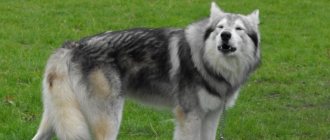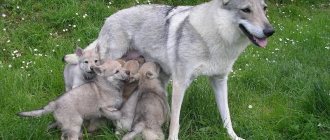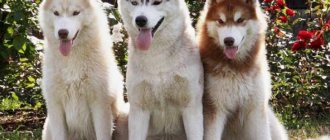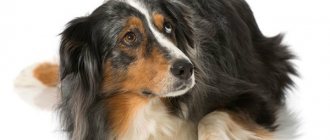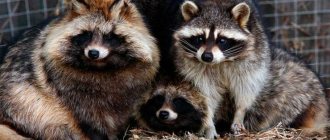A wolf hybrid is an exotic pet that not every dog owner can handle. A serious animal, with wild blood and an equally uncontrollable disposition, is not recommended for home breeding in many countries. In America, hybrids are considered wild animals. And in Russia, this breed is included in the “List of Potentially Dangerous Dog Breeds,” for which the law imposes special breeding and maintenance requirements.
Let's take a closer look at the hybrid of a wolf and a dog in order to clearly understand who we are dealing with - a domestic animal or a wild animal. Let's talk about the characteristics of the hybrid breed, the types of wolf-dogs, the features of their maintenance and upbringing. We hope that this information will help you assess your strengths and understand whether such a pet is right for you.
What is a wolf hybrid
Dogs evolved from wolves over many millennia. But these two species are related and are interfertile. This means that when these two species are crossed, viable offspring are obtained that are subsequently capable of reproduction. A dog crossed with a wolf is called a wolf dog or wolf hybrid.
A similar crossing occurs when two related species of animals are mated by chance or by plan: a wolf and a dog. Accidental mating is possible in the wild, when feral stray dogs mate with wolves. This happens, but not too often. Most often, a pair of dog and wolf is the result of the activities of breeders who cross these two species for the purpose of further sale.
Hybrids also include the offspring of a wolf and a wolf-dog, puppies born from two wolf-dogs.
Why do wolves and dogs mate in the wild?
Mixed breeding between a wolf and a dog in the wild is the result of mating between a male wild wolf and a female domestic dog. Such hybrids occur naturally, but are quite rare. This is because wolves have a highly developed sense of territoriality. They protect their property from encroachment by other species: feral dogs, coyotes.
Gray wolves most often interbreed with large domestic dogs - they are genetically closer to dogs than other wolf species. When does this mixing of species occur? If the wolf population declines sharply for some reason (1 individual per thousand km2), males are forced to look for a mate among other related species. This situation is possible if there is intensive shooting of wolves.
The second reason for the appearance of half-wolves in the wild is the encroachment of people into territories that historically belonged to wolves. That is, if wolves and domestic dogs live in close proximity, their crossing can produce wolf-dog hybrids.
Why are dog-wolf hybrids popular?
In some countries, a fashion has emerged for hybrid breeds. People willingly share photos of their massive semi-wild pets on social networks. To ordinary people, far from biology and genetics, it seems that you can have a pet that will look like a wild wolf and behave like a dog. This opinion is a mistake. A wolfdog is not a dog! A half-breed will never behave like a real house dog. Wild roots will always remind you of themselves. Keeping such a pet is difficult and not always safe; not everyone is up to the task.
Some people love the idea that they can tame a beautiful wild animal, tame it and bend it to their will. Hybrids are indeed very powerful and beautiful animals. They are strong and determined. But you shouldn’t get a pet just to touch the legendary semi-mythical image of a wolf. Such a decision must be balanced and responsible.
The irresponsibility of some owners leads to very sad consequences. People take half-bred puppies, and when they grow up and become wayward and difficult to manage, they are abandoned or euthanized. It’s good if the animal goes to a shelter where it will be taken care of. But not everyone is so lucky. In addition, a mixture of a wolf and a dog is an explosive mixture. Hybrids can be unpredictable and dangerous both for their owners and for others.
Origin story
Interestingly, scientists put forward the theory that the first wolf-dogs appeared many thousands of years ago, since their remains were discovered during excavations in various territories. According to archaeological measurements, the remains were about ten thousand years old.
The wolfdog adopted all the best qualities from its wild ancestors
However, it is quite obvious that even if these remains actually belonged to wolf-dogs, then this hybridization was carried out unintentionally, since ancient people:
- could hardly be concerned with such tasks;
- they were hardly able to catch enough wolves to crossbreed.
Nevertheless, this fact took place.
The first experiment on breeding a wolf-dog was carried out by German breeders who lived in the 14th century. Then wolves were crossed with various breeds of dogs, in particular with poodles, however, despite the fact that at the end of this experiment at least 200 puppies were born, all of them:
- treated people with distrust;
- showed uncontrollable aggression;
- absolutely not amenable to training.
They first tried to breed a hybrid of a dog and a wolf back in the 14th century.
Since this experiment by German breeders was unsuccessful, it had no continuation, and this stage ended.
The second attempt to breed a wolf-dog was made already in 1766 in the homeland of many world-famous breeds - in England. So, local breeders decided to crossbreed a wolf and a shepherd dog. After the first litter of nine puppies was produced, they were given the temporary name "Pomeranian Doggie".
These dogs are used by domestic law enforcement agencies, as their valuable breed qualities have no equal
These puppies were considered unique, and a rather enviable fate awaited them:
- some were sold to the homes of the English aristocracy;
- the remaining puppies became the property of menageries.
At this point, British breeders calmed down.
The next attempt to create a wolf-dog ready to serve man was made by Lander Sarlos, a representative of the Dutch scientific community. It was Lander Sarlos who thought of crossing the wild ancestor of all canines with perhaps the most obedient representative of dogs - the German shepherd. To be more precise, the female wolf became the female in the pair, and the German shepherd became the male.
Black wolfdog
The resulting hybrid received official recognition, in 1962 this breed was updated, and after 19 years these wolf-dogs were again declared unsuitable due to their increased aggressiveness, excitability, etc.
The first among the so-called “normal” wolf-dog hybrids was the Czech wolfdog, which appeared as a result of the experiments of the scientist Karel Hartl. He tried to breed an adequate litter of a wolf and a German shepherd on the same principle as before Lander Saarlos, but instead of a completely wild wolf, he took the role of a female representative of wild dogs, who was raised from a young age by a person, so she trusted people and went with them to war. contact.
Despite the fact that the hybrid of a wolf and a dog is more similar to its wild ancestors, its soul is truly devoted to man
As for domestic wolfdogs, their creation was carried out by government order in Perm, at the Institute of Internal Troops. Thus, as part of the experiment, a natural mating of a tamed she-wolf Naida and a male German shepherd was organized. It is believed that the fact that the breeding happened naturally and did not take place in the laboratory played a big role in the process. The puppies born by Naida became the first domestic wolf dogs. Their further socialization was extremely successful. Their descendants still work for the benefit of the state in various law enforcement agencies of the Russian Federation.
Wolfdog family
The history of the appearance of the wolfdog breed
The first mention of the crossing of dogs and wolves dates back to the middle of the 18th century. However, the deliberate practice of breeding wolfdogs began on Colorado farms in the 1950s. Then a group of enthusiasts, concerned about the decline in the wild wolf population, began crossing them with domestic dogs in order to somehow stop this process. Breeders crossed gray, red and Ethiopian wolves with large dogs: German shepherd, Siberian husky, Alaskan malamute.
Modern hybrids are not the first offspring of a wild wolf and a domestic dog. This is the result of crossing several generations of hybrid breeds with each other. Most purebred wolfdogs can trace their history back to those Colorado dog farms of the 1950s.
Wolf-dog hybrids - what breeds are there?
There are many options for wolf mixes. They all differ in appearance and have distinctive features. Each one is unique in its own way. Depending on what type of wolf and what breed of dog is taken for crossing, the characteristics of the hybrid will depend.
Wolf-dog hybrids, wolf-dogs and wolf hybrids - breeds
We were not mistaken in highlighting these three names. Indeed, in some canine standards these three concepts are not mixed. But let’s not delve into the standards; each country has its own standards; let’s list the most popular existing hybrid species.
- The Alaskan Malamute hybrid (Wolamut) is a mixture of the gray wolf and the Alaskan Malamute. The breed was bred in the USA, but is not recognized by the FCI.
- Alabai crossed with a wolf. Wolf independence, anthropophobia (fear of people), bestialism (hunting poultry and livestock) neutralize all the positive breed characteristics of the Alabai.
- The Kunming Wolf Dog is a German Shepherd crossed with a wolf. To create the breed, wolf species living in China were taken. The breed was bred and recognized in China. The FCI does not recognize the breed. Dogs are used in patrol and search work.
- The Saarloos Wolfdog is a cross between a Canadian wolf and a German shepherd. The breed is recognized by the FCI.
- The Czechoslovakian Wolfdog is a cross between the Carpathian wolf and the German Shepherd. Recognized by the International Film Festival.
- The Italian wolf (Lupo Italiano) is a wolf crossed with a German shepherd. In Italy the breed is protected and its breeding is controlled. The FCI does not recognize the breed.
- Husky Wolf Mix is a hybrid of a Siberian husky and a wolf.
- The Russian Wolfhund is a black wolfdog, the largest of their hybrids.
- A mixture of a wolf and a husky is a species of so-called wolf-dogs, which are not recognized by canine associations. Work on a hybrid of the West Siberian husky and a wolf was actively carried out at the end of the 20th century in the USSR.
Important: serious breeding work to improve the breed qualities of dogs has been carried out by scientists from different countries since 1970 of the 20th century, but all of them did not lead to the desired result. A wolf-dog hybrid acceptable for safe home keeping has never been bred.
Reference
Wolfdogs are a population of wolf-dog hybrids bred at the Perm Institute of Internal Troops from wolves and German shepherds. The scientific leadership of the project is carried out by Professor Vyacheslav Kasimov . Unlike previous experiments on crossing wolves with various breeds of dogs, wolf-dogs are controlled by humans. They have much more developed sense of smell, intelligence and endurance than dogs. They find a person in a confined space in 20 seconds, versus 4–6 minutes for a shepherd dog. It is also noteworthy that, having the size and grip of a wolf, wolf-dogs remain obedient and gentle towards humans. The existing populations of wolfdogs are used to protect the Chinese and Mongolian borders of Russia. The FSB border department works with the breed.
“He is molting, so we didn’t choose a very good time to take pictures. It’s beautiful in winter,” dog handler Vitaly tells me as we walk along the cages with shepherd dogs and Labradors.
The barking doesn't stop. In the penultimate cage, the wolf dog walks from side to side, running in circles. Well, he looks like a wolf. True, a little shabby.
“Argon, alas, is unfit for service, he has too much wolf blood. He is terribly afraid of cars, people, different sounds - it will be impossible to work with him in a group,” explains Vitaly.
Article on the topic
“Dusya, what does it smell like?” The police literally carry their tailed “colleagues” on their arms
Description of the dog breed: wolf-dogs
Although each hybrid breed's conformation is unique, all wolfdogs have common traits. These are powerful, harmoniously built animals, resembling wild wolves in appearance. The “wildness” of half-wolves is noted in their movements, posture, gaze, grin and coat color.
These are strong animals with excellent health. They do not have many of the genetic pathologies that are observed in dogs that became the progenitors of the hybrid. Behind this “beauty of a wild beast,” which involuntarily attracts the eye, hides “animal habits.”
Characteristics of the wolfdog breed
The bestial appearance of half-breed wolves is not the only thing that hybrids have left from their forest parents. Mestizos absorbed the character of both wolves and dogs. But at the same time, due to the unnatural crossing of a wild predator and a completely domesticated dog, some characteristics were enhanced, while others were completely lost.
The more wolf blood flows in the veins of a hybrid, the wilder its temperament will be. This point should always be taken into account when deciding on choosing such a pet. The “animality” of the temperament also depends on how many generations separate your dog from the first wild ancestors.
Wolves mature much later than domestic dogs, so their full temperament is revealed at the time of puberty at 18 months. Half-breeds can show affection towards their family members, children and pets. But they still have wild instincts of predators, so it is unacceptable to leave children and pets alone with half-wolves.
From forest parents, hybrids inherited fear of man (anthropophobia), bestialism (hunting for livestock) and the habit of marking territory with their feces. It is unlikely that anyone would like such qualities of a pet.
In addition, a cross between a wolf and a dog can show strong aggression towards both strangers and members of its own family. So they try to win a higher hierarchical position from a person. Cases of wolf mestizos attacking humans are not uncommon. This undesirable characteristic is the most common reason pets are abandoned and brought to animal shelters.
Wolfdog of Saarloos
Czechoslovakian Wolfdog
How does a wolfdog puppy differ from dog puppies?
Until wolfdog puppies have reached sexual maturity, they can be mistaken for the offspring of an ordinary domestic dog. The striking features of hybrids appear after age-related changes in the hormonal background of the animal. However, even the smallest half-breed wolf cubs are different from dog cubs.
How can you understand that this is a half-breed puppy:
- Offspring develop unpredictably. The main developmental stages of dogs and wolves occur at different times. The rate of development of puppies is difficult to predict.
- Early interaction of hybrid offspring with humans is difficult. It takes much longer for puppies to get used to people and stop being afraid of them.
- Hybrid puppies received fear of new sounds and visual stimuli from wolves. They are afraid when they first begin to see and hear. Dog offspring do not have such sensory shocks.
Italian wolf (lupo italiano)
I wanted a dog since childhood
Vitaly Dzyuba from the village of Severskaya, Krasnodar Territory, became a dog handler not by chance - he loved dogs since childhood.
“I grew up, served in the military service, where I headed the canine service, trained service dogs, then stayed to work under a contract, graduated from the Higher Military Command School of the Internal Troops of the Ministry of Internal Affairs in Novosibirsk, and moved here in 2007. And a year later he began working in the canine service - he fulfilled his childhood dream,” says Vitaly. “There are a lot of dogs here, and we are the masters of all of them!”
While working at the Ministry of Internal Affairs, dog handler Vitaly often thought about how to get such a dog so that it would be more resilient, could pick up a scent even after three days and have a strong sense of smell.
“I heard about Vyacheslav Kasimov’s experiments with wolf-dogs for a long time and really wanted to repeat them. But the difference is that the professor started with a she-wolf, and I decided to go in a different way, with a wolf. In 2009, we had a small territory outside the Seversky district, where we kept enclosures with dogs and wolves. Dog handler Vasily Shavrygin kept wolves. He had a whole zoo there - horses and camels,” recalls Vitaly.
Then the dog handler decided to cross a wolf with a shepherd. With a shepherd, not a service one, but his personal one. This is important to note, since the crossing experiments are Vitaly’s personal initiative.
As a result, there were 6 puppies, Vitaly gave five to Shavrygin, and one, according to his observations, the strongest, he kept for himself. He called it Argon.
Externally, the shepherd dog with which the wolf was crossed looked something like this. Photo: AiF/ Alina Menkova
“We were afraid that the wolf would kill the shepherd after mating. This very well could have happened, but fortunately it didn’t happen.”
Argon lived in Vitaly’s private house from the age of a month.
“I noticed wolfish habits in him - he was very timid, he was afraid even of a falling branch. But at the same time, he did not fawn on me like a dog, and rarely wagged his tail. In general, in order for a wolf-dog to have a trusting relationship with its owner, one must show sufficient rigidity and be the “leader of the pack.” A wolf-dog hybrid has no loyalty to a specific person; they adapt more quickly to new people.”
Vitaly Dzyuba tells how he became a dog handler. Photo: AiF/ Alina Menkova
How to properly deal with half-wolves
To keep an exotic half-breed pet, you will need to create special conditions and learn how to handle them. Without certain knowledge of the physiology and psychology of mixed breeds, this venture may turn out to be a failure at best. And at worst, lead to serious irreparable consequences for both the pet and its owner.
These types are not suitable for home apartment maintenance. Throw away the idea of getting a wolf hybrid if you only have a city apartment to spare.
For content you will need:
- Lots of space away from other people and noisy highways. A farm somewhere in the forest is an ideal place to keep this breed. The following habits were passed on to the hybrids from wolves: howling loudly and constantly wandering. They need the presence of wildlife to explore. There they will not disturb their neighbors with their howling, and the noise from cars will not frighten the pets.
- The space in which wolves are kept must be at least 0.2 hectares per individual. This should be a securely fenced area with a high fence (2.5 meters) so that the animal cannot jump over it. And a deep concrete foundation so that the pet cannot dig under it.
- It is best to enclose the space for keeping hybrids with a double fence with teeth curved inward.
- It is necessary to ensure good soil drainage in the area so that animals can find dry areas in rainy weather.
- The booth is not suitable for keeping wolfdogs. It is necessary to build a spacious house with a high shelf so that the pet can occupy a position on a hill.
- Low-growing shrubs and trees should be planted on the site so that the animal finds shelter in the heat. It is unacceptable to plant tall trees near a fence - the pet may run away!
- The gates are installed high - 1.8-2 meters. Gate latches must be reliable.
Important: immediately evaluate your ability to create the right space for keeping wolf hybrids. If you are not ready to provide your pet with such conditions, give up the idea of getting a wolf-dog.
Are wolf-dog hybrids trainable?
Mixed breeds of wolves and dogs are naturally intelligent and quick-witted. But they are also stubborn, self-willed and very energetic. To keep your pet in good shape, you need 1 to 3 hours of physical activity per day. You need to walk them a lot and actively.
Let's look at the educational and training features of wolf-dog hybrid dog breeds.
- The offspring of wolves and dogs are more difficult to train. These puppies have stronger instincts and are ready to follow them.
- The person must immediately indicate to the pet that he is in the role of the alpha male. Weak owners will not be able to constantly maintain this position. The pet will always try to take a dominant position, expressing this through disobedience to the person, refusal to follow commands and demands.
- Half-breeds have a strong fear of new situations and people - this makes training difficult.
- Toilet training on the street causes certain difficulties. Wolves are accustomed to marking their territory with feces. When they defecate at home, it is a territorial instinct, not a protest.
- Wolf instincts and aggression can trigger at any moment. A pet can attack a child, another pet, livestock or bird.
Husky Wolf Mix – a hybrid of a Siberian husky and a wolf
How to feed breeds that are wolf-dog hybrids
Conventional dog food is not suitable for feeding hybrid breeds. The diet of such a dog should consist of fresh meat. The best options are wild game, elk, bison, beef, lamb, rabbit, chicken and turkey. Pork causes digestive problems and should be avoided.
The meat is given raw along with the bones. Bones are not a problem for wolf descendants. They do a great job with them. The descendants of wolves do not need cereals. Pets are given fruits, vegetables and fresh herbs as sources of vitamins and fiber. The area where the pet is kept must have grassy soil so that the animals can eat grass.
To compensate for the lack of vitamins and minerals, you need to give fortified supplements as prescribed by your veterinarian. Particular attention should be paid to access to fresh fresh water. It is best to organize a drinking trough on the site, similar to the kind they make for keeping livestock. During the hot season, it would be a good idea to place a children’s pool on the property so that your pet can drink and swim in it.
Health of wolf-dog hybrids
Crossbreeding species with different genetics has a positive effect on the health of the offspring. Puppies that result from mating between wolves and dogs are much stronger and healthier. They do not exhibit those breed genetic pathologies that are inherent in purebred dogs. This proven fact was the main reason why people wanted to crossbreed dogs with wild carnivores. But such crossing has its pros and cons.
Advantages and disadvantages
To make it easier for you to form your attitude towards this hybrid of a wild predatory animal and a domestic dog, we have summarized all the information and highlighted the main pros and cons of the hybrid breed of dog and wolf.
Pros:
- high intelligence;
- strong attachment to the owner;
- endurance;
- high performance characteristics;
- unpretentiousness in food;
- excellent health;
- unpretentiousness to conditions of detention.
Minuses:
- a pronounced desire for dominance;
- cause fear in other people;
- do not strive to please the owner;
- require large space for maintenance;
- require long hours of physical activity;
- they like to dig, they can spoil plantings and destroy flower beds;
- constantly mark the territory with their feces;
- hunt livestock and other pets;
- suffer from anthropophobia;
- behavior is inconsistent and difficult to predict;
- extremely curious, can damage things, furniture, communications.
Why the breed is not recommended as a pet
Although there are examples in the world of successfully keeping pets that are a cross between a wolf and a dog, they are rare. Much more common are stories of keeping half-breeds that ended in tears. Therefore, all over the world, biologists and dog handlers are against the thoughtless and irresponsible ownership of such animals.
When a pet is kept in conditions inappropriate for its mental and physical development, there is always a risk to human safety. It is unacceptable to put a wolf-dog on a chain or lock it in a cramped cage - all this embitters the pet and makes it aggressive and dangerous to others. Every year thousands of half-blooded wolves die, whose owners were not ready to create the necessary conditions for their maintenance and care.
Owners ask veterinarians to euthanize their pets when they grow up and show a “wolfish disposition.” At best, animals can be saved if there is a shelter willing to take them in. Re-adopting such a pet into a family is very problematic. Compounding this problem is the fact that no rabies vaccine has been developed for the hybrid species. The usual vaccination against this deadly disease does not work on a cross between wolves and dogs.
Russian Wolfhund - black wolfdog, the largest of their hybrids
Mix of wolf and husky
What do puppies inherit from a wolf and what from a dog?
The first experimental puppies inherited the worst traits of a wolf: selfishness, distrust, wariness, deceit. But they also took a lot of good qualities: a unique sense of smell, since the wolf is able to pick up a trail even three days old. For comparison, a dog has the same figure of 8–10 hours. A cross between a wolf and a dog is much hardier and stronger than ordinary dogs, wolf-dogs get sick less and can live 25–30 years, while German shepherds only live 10–15 years. In winter, wolf-dogs can do without a winter enclosure and lie calmly in the snow even in frosty weather.
“I did not vaccinate either the first or subsequent experimental puppies, solely so as not to mix anything into the blood. And I must say, the puppies were not sick,” notes Vitaly.
The wolfdog Argon is now molting. Photo: AiF/ Alina Menkova
Why are biologists against breeding the wolf dog breed?
Biological scientists are sounding the alarm and believe that the interbreeding of wolves and dogs in the natural habitat of predators can lead to the displacement of wolf populations from their habitats. More frequent mating events may have a negative impact on the destruction of the genetic identity of the gray predator.
Breeding such species for commercial purposes is also criticized by scientists. They claim that most of the offspring from such breeding die a year after birth. And hybrids that have reached puberty are threatened with death at the hands of humans because at this age wolf traits are clearly manifested in animals. At the age of 3-4 years, these half-breeds feel like either dogs or wolves. They cannot decide on their nature.
Common myths about the half-wolf
The unusual exterior and temperament characteristics of the wolf-dog, combined with the ignorance of ordinary people, led to the emergence of myths. What is true and what is false, we will try to figure it out together with you.
Myth 1
Huskies are half-wolves. This is not true. To the question: is a husky a wolf hybrid? There is a clear answer. No, it doesn't apply. The Siberian Husky is a breed of dog. There is no wolf blood in the veins of a husky.
Myth 2
A mixture of a wolf and a dog is an ideal guard breed. It's a delusion! Wolves are more shy, and their aggression is uncontrollable, so mestizos are not suitable as watchmen.
Myth 3
Mixed wolves live longer than dogs. Another erroneous statement. In captivity, wolves live 12-14 years. This is comparable to the average lifespan of any large dog.
If our article has not dissuaded you, you still want to get yourself an exotic, spectacular pet, think about other breeds. There are many domestic dogs in the world that look like a wolf, but have a calm disposition and are human-oriented.
Yuki - America's most famous wolfdog
What to feed a wolf-dog hybrid?
A half-wolf's diet has to be planned much more carefully than that of an ordinary dog. First of all, protein foods should predominate in it, which is represented by:
- meat;
- by-products.
By-products should be included in the diet of wolfdogs
In this case, it is best to take beef, but it is also suitable for feeding wolfdogs:
- chicken;
- horsemeat;
- veal;
- turkey, etc.
As for by-products, they can be given no more than once a week. Suitable for feeding:
- beef liver;
- beef heart;
- chicken liver;
- beef lung;
- chicken hearts, etc.
It is strictly prohibited to feed wolfdogs with canned food. By the way, they also perceive dry food quite poorly, since their digestive system is completely unadapted to such processed food.
The ancestors of these dogs in the wild feed exclusively on raw meat, so dry food is not suitable for feeding.
You can mix meat food for wolf dogs with cereals, for example, buckwheat or rice, since these dogs need carbohydrates in small quantities. The consumption of fermented milk products by wolf dogs, for example, cottage cheese or fermented baked milk, yogurt, and natural yogurt without dyes, will also have a beneficial effect. You can give your wolfdog raw or boiled eggs in small quantities, as well as boiled vegetables, such as carrots and zucchini. However, in nature, the wolf dog gets its fiber mostly from herbs, so even if you don’t give your dog vegetables, it will sometimes eat dandelions or other healthy herbs.
It is not easy for an ordinary citizen to make such a friend today, however, perhaps in the future wolf-dogs will become faithful companions of anyone who wants them
